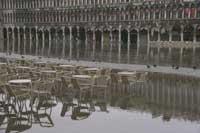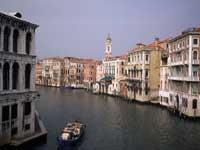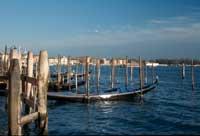Venice, the city of the canals

Saint Mark's Square is located in the centre of the city of Venice. At the beginning of the century it was flooded ten times a year. At present, a hundred times. In these cases, tourists continue to raise pants and photograph themselves. But these floods are not only an anecdote, but they are also advertisers of the dark future of Venice.
Project Mose
According to experts, if something is not done, within a few years it will be covered by the water of Venice. In view of this, it seems that the Venetians have no intention of remaining still. Last year, the Mose project was approved for the construction of giant dams that make it difficult to enter water. It is, without a doubt, an enormous project, since in ten years mobile containment walls will be built to close the three accesses to the sea. The execution of the project would mean 400.000 euros.
The idea of the Mose project is not new, it was first presented in 1980. The debate began then, but it is not yet over. The ecological groups have shown themselves totally against, arguing that with the execution of this project the balance of the existing ecosystem will be modified.

From the point of view of the protection of nature, this type of solutions can generate many problems. The loss of the natural sediment and the wetland, the degradation of the soil, the accumulation of pollutants of industrial origin in the bay and, in general, the loss of water quality are the main concerns of the ecologists regarding this construction project.
However, in the Venetian lands the balance was broken long ago. In fact, Venice is a pond formed by sediments accumulated in thousands of years by rivers ranging from the plain to the Adriatic. The pond is not sea, until it there are 50 kilometers of land and sand. The sea has only three accesses: Lido, Malamocco and Chioggia. For these three zones the salt water enters and for them the salt water leaves.
In the fifth century, a community began to dry up land, building canals, covering lagoons, diverting rivers… until building the city from generation to generation. Of course, in this centuries-old struggle, some moments have had more importance than others. For example, the year 1501 is a marked year, since the rivers Sile, Piere and Brenta decided to deviate. These three rivers were the main rivers that reached the pond. It took two centuries to carry out the work. These works allowed the boats to access the raft and reach the port. Despite the blow, the raft was able to maintain the balance.

One of the hallmarks of Venice is the canals.
But a real blow XX. He arrived in the 1950s. In order for the oil tankers to arrive to the industrial port of Marghera the oil channel, a direct channel of 15 meters deep, was built. The entire environment was filled with chemical and petrochemical industries. The factories were getting more and more water from the pond, using it, dirty it and pour it again. The balance broke. The pond, an ecosystem of fresh, salty and brackish water, has become a swamp on the shores and in the centre of the sea. Oil tankers, merchants and large boats for tourists provoke great waves.
As a result, sand banks, silts and algae that were formed with the passage of the tides have been destroyed and erosion has increased. Erosion eats the bottom of the pond and the foundation of buildings. The conclusion is clear: In 1990, Venice was 23 centimeters below the beginning of the century.
A dark future
The containment walls that are about to be built in the Mose project will serve to maintain periodic floods, but some consider that they will not be enough to prevent the sea level from rising constantly. The need to take other measures seems inevitable.

In this sense, researchers from the university of Padua, led by Giuseppe Gambolati, have launched a new proposal to save Venice: to climb a few centimeters the city.
The same idea is not new, it was already raised in the 70's. According to Gambolati, since then technology has advanced a lot and it is already possible to pump fluids under Venice to lift the city. This technique would help extend the life of the Mose project, since in ten years the city would rise 30 centimeters.
However, it is still necessary to carry out extensive geological and geophysical studies that determine the viability of the project. After all, the Venetians have been facing nature for centuries, and one day they may have to despair. Yet, for the time being, they are not willing to give in, and seem willing to protect at all costs the cultural legacy of their ancestors.
Published in 7K.
Buletina
Bidali zure helbide elektronikoa eta jaso asteroko buletina zure sarrera-ontzian










